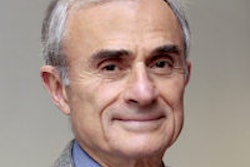
In an opinion published on July 15 in the Journal of the American College of Radiology (JACR), Dr. Michael Brant-Zawadzki of Hoag Memorial Hospital Presbyterian in Newport Beach, CA, and Dr. Richard Afable of Covenant Health Network in Irvine, CA, and suggest a population health management model that harkens back to capitation proposals that were the centerpiece of healthcare reform in the 1990s -- but with a twist. AuntMinnie.com spoke with Brant-Zawadzki about the model and how it could work for radiology.
AuntMinnie.com: Our current healthcare system is based on a fee-for-service model. What's the problem with that framework?
 Dr. Michael Brant-Zawadzki.
Dr. Michael Brant-Zawadzki.
Brant-Zawadzki: Right now, healthcare providers compete for available funds, and the distributors of those funds are insurance companies. The money is distributed in a fragmented way, negotiating variables such as providers' rationales for services, how complex the service is, and the location of the service. This model results in excessive utilization, as well as duplication of services, inefficiency, and waste.
Fee-for-service emphasizes volume over value, and radiologists are pressured to read more and more -- and disregard other clinical responsibilities. They become line workers. And the advent of teleradiology has only made this worse, so that the read becomes a commodity.
In the opinion you wrote for JACR, you describe a concept called "population health," taking care to say that it's not "managed care light." What is it? Is it essentially capitation?
Population health is similar to the capitation model of the '90s, but it differs in that it's not aimed at rationing healthcare. Instead, it's organized around patient satisfaction and patient experience, as well as budget.
Let's say that $10 billion was set aside for a particular hospital system. The system then creates incentives for providers and patients that will support efficiency and coordination in healthcare. If a portion of this $10 billion is left over, everyone is rewarded -- providers earn more and payors spend less.
That's the essential concept of population health. It changes the system from an episode- and provider-centered one to one that benefits payors, providers, and patients.
How would radiologists benefit from this model?
Paying per transaction incentivizes transactions, and radiology has been pressured into prioritizing the efficiency of providing reports, because that's what has boosted reimbursement. Where we get is that reports are commoditized and cost becomes the main factor that determines who gets the reads. This neglects other components of the service radiologists provide. A population health framework could allow radiologists to be significant partners in both shaping the delivery of healthcare and managing patients.
So what kind of role could radiologists play in a population health framework?
Radiologists have traditionally been consultants. In the good old days, radiologists had the luxury of consulting because reimbursement for reads was more generous. So even if the consultation wasn't directly reimbursed, it was valued.
Under a "read-for-hire" mode,l this doesn't happen. So as the population health framework develops, radiologists need to re-emphasize the value of those additional nonread services they provide.
The role that radiologists can play by providing services to physicians is huge. Radiologists have a broader and deeper knowledge base than primary care physicians as to how to triage patients and how imaging data should flow. Radiology is intrinsic to the healthcare enterprise, and radiologists can help manage the disease care process. We need to shift radiologists from being data providers to being managers of information.
And radiologists can step up into leadership as this healthcare delivery transformation continues to progress. We've long been innovators in healthcare technology -- the IT of the clinical enterprise -- and we're familiar with high-volume situations and the need for efficiency. Although most radiologists gravitate to solving diagnostic puzzles by reading cases, some enjoy management and can serve in this way.
Would a population health model change the way radiologists interact with patients?
The Affordable Care Act introduces the notion of different tiers of care, and it sets the tone for the population health model. It makes patients accountable for their own healthcare, in that they get to decide how much they can or want to pay themselves -- everyone gets access to a certain basic level, but if you want a higher level of services, your premiums will be higher, and if you keep yourself healthier, they'll be lower.
In this type of consumer-driven environment, radiologists need to think about how to best communicate results to both referring physicians and to patients -- and they can go directly to patients with exam results. Rather than patients waiting to hear from their primary care physician, and then discussing results with the radiologist if need be, radiologists can help patients have access to their exam information in real-time.
There are groups out there that have created patient consult services. In our hospital, we have a lung cancer CT screening service that patients pay for out of pocket. These patients get a printed letter with their results as they go out the door. They want to know the information as soon as possible.
How would you describe the future of radiology?
It's not where radiology will go, but what role radiologists will play in the delivery of healthcare. Radiologists need to decide whether they will be defined simply by the productivity mode or if they will use their core skills to help manage healthcare.




















